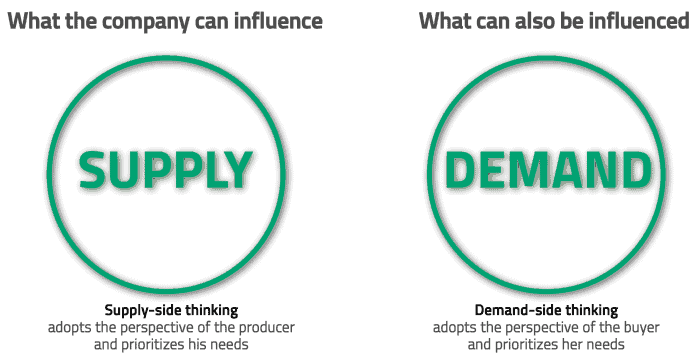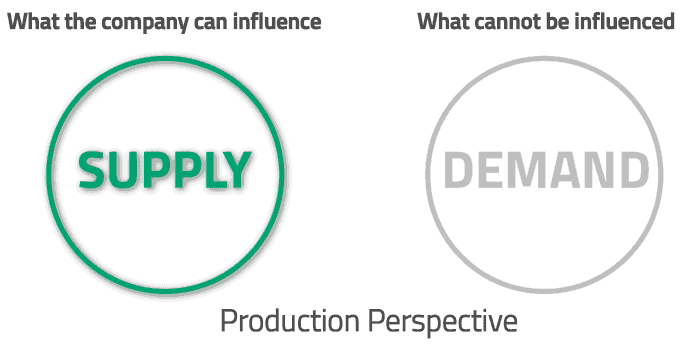Brief History of Marketing – Is Your Strategy Stuck in the Dark Ages?
If you work for a mid-sized company that is looking for growth, we suggest rethinking the business paradigm your business operates under....
26 Mar 2025 8334 ViewsIn the early 1800s, the majority of products available to consumers were traded as commodities. Around the turn of the 20th century, a small group of economists in the US became aware that commodity markets could be influenced by factors other than the mere existence of supply and the application of sales tactics. They discovered that companies could actually stimulate demand in the market with a new concept they called “marketing.” Want to learn more about the history of marketing? Keep reading!
Brief history of marketing – everything you should know
When discussing the history of marketing, it’s important to mention that marketing as a discipline of economics was defined as the sum of activities a seller utilized to stimulate demand for its product in a defined market. The idea of stimulating demand, or pull, in the market was a radical idea. Up until this point, demand was simply satisfied through push tactics, like distribution and sales, but it had never been purposefully generated before.
Those companies that decided to apply the idea of marketing had to make two inherent changes:
- First, they needed to understand the three levels at which consumers assess the value of a product, and then figure out how to manage those three aspects of their product.
- Second, they needed to create a process within the company to routinely assess buyer needs, and then to answer them with a combination of product, price, place, and promotion.

Important companies in the marketing history
Procter & Gamble was among the first companies in the marketing history to fully embrace this idea. They focused the entire company around the discipline of marketing and soon developed an enormous competitive advantage. However, P&G was in the minority. Somewhere along the way, most other businesses began defining marketing as promotion and forgot about all the rest. That’s why the word “marketing” is often used interchangeably with “advertising.” However, a company that only promotes its brand isn’t really practicing marketing, it’s simply using promotion as sales support to push its product into the market.
Discussing the history of marketing, it needs to be mentioned that most mid-sized companies today have marketing departments. However, the activities of these departments often seem more in line with a sales support function than as playing a strategic marketing role. These companies are still operating under a set of archaic business assumptions that pre-date electricity. They have not yet incorporated strategic marketing principles into their day-to-day operations. The vacuum that created, as we see it, is the one of the biggest untapped growth opportunities for many sales-driven, mid-sized companies today.
Click and find out more about digital growth strategy.
Business Paradigms
Based on the marketing history on its most fundamental level, the course of action we recommend for such companies is a shift in business paradigms.
A paradigm is defined as “A set of assumptions, concepts, values, and practices that constitute a way of viewing reality for the community that shares them.” Basically, a paradigm defines how individuals interpret reality and see the world around them. Which is exactly what makes it so challenging to change.
People typically do not recognize a paradigm until they are outside of it and in the middle of the next one. Does a fish know it’s swimming in water? Probably not, because that’s all a fish knows. In fact, a fish would only know what water is if it were dragged out gasping into the air. Paradigms are like that.
In brief history of marketing, a paradigm is a way of thinking that is so pervasive, so taken for granted, that it is invisible to the people operating within it. It’s not an idea about reality. It IS the reality from which we view the world. We have divided that world view into two paradigms: the Production Paradigm and the Marketing Paradigm. These two paradigms apply to business-to-business as well as business-to-consumer.
1. Production Paradigm
If we boil business down to supply and demand, the Production Paradigm is a business outlook that is heavily laterized to the supply side of the equation. It sees the supply side as its sole sphere of influence. It operates under that assumption that the efficient production and distribution of supply are its strongest and most effective drivers of growth and profit.
Looking at the marketing history, this made sense back in the era of the steam engine, when:
- mass production was new
- mass distribution was new
- mass marketing had not been invented yet
- digital communication and distribution didn’t exist
- traditional mass communication was primitive and paper-bound
- peer-to-peer communication was restricted to face-to-face
- markets were broadly under-served by mass marketers
- there were very few products in the market
- competition was minimal
The Production Paradigm evolved as a means for companies to extract optimal value from this specific business environment. Clearly, this environment bears little resemblance to the business world of today.

The Production Model assumes sufficient demand and, therefore, focuses primarily on supply-side factors to generate profit. This method requires satisfying the needs of the company with regard to greater efficiencies in production and distribution. In contrast, the Marketing Paradigm assumes that production and distribution efficiencies are vitally important, but are still the easier problem to solve in a market where competition exists. It, therefore, focuses primarily on generating profit by influencing demand.
This requires satisfying the needs of the target with regard to mining more relevant insights (also those based on the history of marketing) to provide more relevant innovation than competitors across the marketing mix are able to do. For that reason, the core business models for a Marketing-oriented company are the value loop and brand equity cycle.

In the Value Loop, the value journey starts at the other end, with the target. Insights mined from the target market become the most precious raw material for production. These insights are based on the target’s ever-changing needs, preferences, options, and perceptions.
They inform the entire marketing mix: Product, Price, Place, and Promotion. By constantly adapting the mix to changes in the market, the marketing company differentiates their offer and is able to generate demand that is specific to their brand. This, in turn, gives them more flexibility in their pricing, which has a direct and profound effect on operating profit. And, unlike the Production Paradigm, marketing companies don’t use a sales funnel. Like the value chain, the sales funnel is a finite business process that discards prospects after the purchase and is inherently wasteful.
Once a marketing company has invested in acquiring a customer, they protect and nurture that investment with the brand equity cycle approach that puts as much emphasis on customer retention as it does on customer acquisition.
The brief history of marketing shows that the Marketing Paradigm suggests that demand itself could be increased. At its core, this bold idea defined marketing as the sum of activities that can influence demand, or pull, for your product category or brand. At the turn of the century, when economists suggested to CEOs that supply wasn’t the only thing under their influence and that they could increase profits by influencing demand as well — this was a very radical idea.
So extremely radical, in fact, that most companies stuck to their old ways, as many present-day companies still do. Today, we can see a clear division between primarily production-focused companies, which are still operating off the Production Paradigm, and market-focused companies operating off the modern paradigm.
2. Marketing Paradigm
 If we boil business down to supply and demand, the Marketing Paradigm is a business outlook that works both sides of the equation. It sees both the supply side and the demand side as being under its sphere of influence. But, since supply-side processes and technology are mature, widespread, and fairly efficient (as evidenced by the marketing history), the competitive gains provided by focusing here are typically marginal and diminishing. Therefore, it is less of a focus. Demand-side gains, on the other hand, provide significant and infinitely expanding returns. Given that, under the Marketing Paradigm, companies operate under that assumption that the efficient production and distribution of supply are essential, but its strongest and most effective drivers of growth are demand-side stimulation. The demand-side thinking doesn’t displace or diminish supply-side efficiencies, rather it simply builds upon them.
If we boil business down to supply and demand, the Marketing Paradigm is a business outlook that works both sides of the equation. It sees both the supply side and the demand side as being under its sphere of influence. But, since supply-side processes and technology are mature, widespread, and fairly efficient (as evidenced by the marketing history), the competitive gains provided by focusing here are typically marginal and diminishing. Therefore, it is less of a focus. Demand-side gains, on the other hand, provide significant and infinitely expanding returns. Given that, under the Marketing Paradigm, companies operate under that assumption that the efficient production and distribution of supply are essential, but its strongest and most effective drivers of growth are demand-side stimulation. The demand-side thinking doesn’t displace or diminish supply-side efficiencies, rather it simply builds upon them.
This aspect of the history of marketing makes sense in this information era, when:
- mass production is mature
- mass distribution is mature
- mass marketing is mature
- digital communication and distribution is the norm
- traditional mass communication is in decline
- peer-to-peer communication is growing fast
- markets are broadly over-served by mass marketers
- there are many products in the market
- competition is intense
The Marketing Paradigm evolved as a means for companies to extract optimal value from the business environment outlined above. The internet has simply amplified the advantages of it as compared to the Production Paradigm.
Summarizing our brief history of marketing
If you work for a mid-sized company that is looking for growth that will take you to the next level, I suggest you step back and try to gauge the paradigm your business is operating under. The approach is as valid for business-to-business as it is for business-to-consumer. In fact, we’ve seen some of the most dramatic gains made by companies that do business in commodity markets that are both deeply entrenched and fully resigned to the Production Paradigm. We have found that examining the history of marketing and shifting from a Production Paradigm to a Marketing Paradigm can provide an immense competitive advantage and help accelerate growth.
Wondering why so many marketing initiatives fail? Check out our blog!
Like this post? You'll find more marketing insights in my new book: International Brand Strategy: A guide to achieving global brand growth, now available from booksellers globally. Order your copy here.








One replay